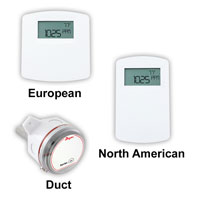Carbon Dioxide Control in Educational and 24-Hour Occupancy Buildings
Carbon Dioxide Control in Educational and 24-Hour Occupancy Buildings
Dwyer Instruments, Inc. has been an industry leader in the building automation market for quite some time now, offering devices for use in all types of sensing applications. Historically known for pressure instrumentation, Dwyer is continually expanding its line of control peripherals to include: relative humidity, temperature, air velocity, carbon dioxide (CO2), nitrogen dioxide (NO2), and carbon monoxide (CO) transmitters.
An area that has seen a rapid growth in American demand lately is CO2 sensing. Recent studies1 have shown that the indoor CO2 concentration can affect one’s decision making skills in a negative way. As such, many schools have mandated that the CO2 levels continually be monitored to ensure that students and teachers are not affected by this phenomenon. The Dwyer Series CDT Carbon Dioxide/Temperature Transmitter is the solution to this problem.

The CDT-RLY can be used as a thermo-stat style control for the CO2 levels in the room, without needing to be tied back to a central control system. The typical setup in schools is to have the relay activate when the CO2 concentrations are too high. The settings allow you to set high and low set points to create a differential in the system, which in turn prevents chattering of the relay at the high set point. When these parameters are reversed (the high set point being set to below the low set point), this reverses the action of the relay. With the reversal in the parameters, the relay will activate when the CO2 concentration drops below the high set point, and deactivate when the CO2 level reaches the low set point.
An interesting note is that the Dwyer CDT also has a leg up on the competition for a high-CO2 application. Through our use of single-source dual-wavelength NDIR technology, the CDT can keep a reliable calibration in university buildings or any 24-hour occupancy/high level CO2 areas. Dual-wavelength NDIR uses two separate light sensors, one of which (the reference) is filtered to 400ppm CO2 while the other (the output sensor) is reading the actual environment CO2. This allows the CDT to constantly recalibrate itself to a known value (400ppm) and does not allow the calibration to drift as in single-wavelength devices offered by the competition.
Through the use of Dwyer’s Series CDT-RLY Carbon Dioxide/Temperature Transmitter, schools, university facilities, or any building running a 24-hour occupancy can now gain accurate control of their CO2 levels at a reasonable cost.
1: http://newscenter.lbl.gov/feature-stories/2012/10/17/elevated-indoor-carbon-dioxide-impairs-decision-making-performance/
